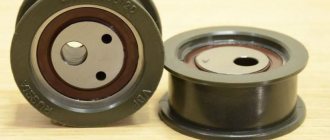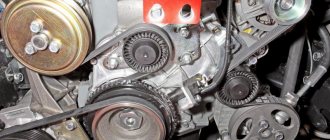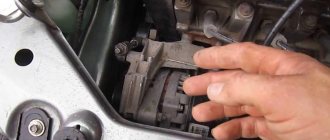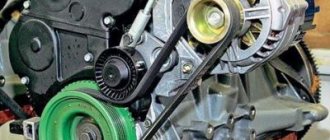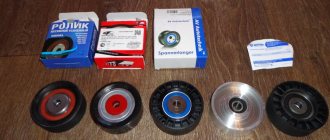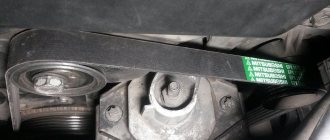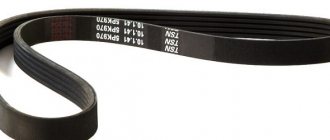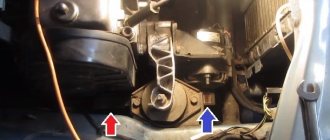According to the technical documentation, the alternator belt must be changed every 45-60 thousand km. You should also not forget about the quality of vehicle maintenance, since this directly affects the service life of the parts, in this case the belt. If you notice significant cracks or damage on it, do not hesitate, it is better to replace it.
Video material
The video will tell you how to change the Hyundai Accent attachment belt yourself
Replacing the alternator belt Hyundai Accent: instructions
According to the technical documentation, the alternator belt must be changed every 45-60 thousand km. You should also not forget about the quality of vehicle maintenance, since this directly affects the service life of the parts, in this case the belt. If you notice significant cracks or damage on it, do not hesitate, it is better to replace it.
Video material
The video will tell you how to change the Hyundai Accent attachment belt yourself
Elimination methods
A squealing belt is perhaps the only reason why a whistle may occur when starting the engine. This means that the drive element has stretched and is slipping along the pulley. So, this significantly increases the wear of the belt itself, which will inevitably lead to tragedy in the power unit, unless, of course, the situation is corrected in time. Let's consider repair and diagnostic operations to eliminate whistling in the engine.
Timing drive
A whistling sound in the engine caused by a faulty timing belt is more than an urgent repair. If the part is not replaced in time, this will lead to a break in the drive, and at the same time to bent valves, which inevitably leads to costs.
The average, even the best belt should be changed no later than 50-70,000 km. Typically, car manufacturers indicate the maintenance interval for the timing belt unit in technical documentation and service books. In any case, the motorist must monitor the condition of the components and parts of the engine of his vehicle.
Replacement process
Like every part in a car, the alternator belt is subject to wear and therefore needs timely replacement. Therefore, the manufacturer recommends checking the auxiliary drive belt in accordance with routine maintenance 2. This happens every 30,000 km. And change it as it wears out or cracks, tears, peeling of the fabric base and other defects appear on it. However, it should be remembered that the belt performance tests were carried out in factory conditions. Therefore, when operating a car in difficult conditions, the need to check or replace the belt may occur much earlier than expected.
To replace the attachment belt (also known as the generator belt), you must have the following tools:
- inspection hole or overpass;
- ratchet with extension;
- head at “17”;
- keys for “17”, “14” and “12”;
- vice;
- the belt is new.
Let's consider the process of replacing a belt step by step.
- We install the right side of the car on a jack or on an overpass (if there is one)
- Remove the negative terminal from the battery.
- Unscrew the top bolt securing the generator.
- Install the belt.
- We tighten the tensioner.
- We tighten the belt.
- Tighten the generator bolts.
- We start the engine and make sure there are no unnecessary noises or squeaks.
The peculiarity of the bypass strap tensioning system is also its main problem. A distinctive sign of a belt failure is a whistle emitted during operation. The whistling is more often noticed in damp and cold seasons, but if the belt is working on the edge, then the whistling can be heard constantly.
Replacement algorithm
Before changing the air conditioning belt on a Hyundai Accent, you need to remove the right mudguard of the power unit. This is done as follows:
- We drive the car onto a viewing hole (overpass, lift). Open the hood and, using a Phillips screwdriver, unscrew the piston bolt that holds the mudguard fastening system. The piston must be pulled out.
- We climb under the bottom of the vehicle, find the screws holding the mudguard fastening from below, and use a 10mm wrench to unscrew them. After removing the mudguard, it is also recommended to remove the wheel - in this case, the replacement procedure will be more convenient and faster.
- To get to the A/C pulley, you must first remove the alternator belt. To do this, use a 12mm wrench to loosen the generator mounting nut. Using the same tool, unscrew the adjusting bolt to loosen the belt tension.
- After this, we move the entire drive of the auxiliary units towards the cylinder block, which will allow access to the air conditioner pulley. Remove the belt from the shafts.
- Since we previously loosened the Accent air conditioning belt tensioner, we can now completely unscrew the adjusting bolt without any problems. Now we remove the air conditioner belt - the first part of the task is completed.
- We install the new belt in its original place. To tension the air conditioner belt, use a 12mm wrench to loosen the screw that secures the generator to the oil pump. We begin to slowly rotate the adjusting screw until the pulley is sufficiently tensioned. Note that the tension should be moderate - when pressed from above, the belt should move vertically by 5 - 7 mm. If you clamp the Hyundai Accent air conditioner belt tensioner roller too tightly, the load on the bearings during rotation of the generator shaft will be constantly increased, which can cause their premature wear. The same trouble awaits the refrigerant pump bearings.
- After tightening the strap, you should tighten and tighten all the bolts and screws that were previously unscrewed or loosened.
- All subsequent operations should be performed in reverse order. The last thing to install is the mudguard.
Part selection
For a complete replacement on a Hyundai Accent, the following belt is suitable:
| Vendor code: | Trademark: | Manufacturer country: | Width, m | Height, m | Length, m | Weight, kg |
| 6PK2137 2521225000 | Hyundai/Kia | South Korea | 0.2 | 0.025 | 0.23 | 0.245 |
Replacement belts: original poly V-belt from company 2521225000. Price 1,500 rubles.
But you can use more accessible analogues:
| Manufacturer | vendor code | Prices in rubles |
| Dayco | 6PK2130 | 1500 |
| Hutchinson | 2140 K 6 | 1000 |
| Meyle | 050 006 2140 | 1000 |
| Bosch | 1 987 947 958 | 1000 |
| Finwhale | BP6PK2138 | 1100 |
| Flennor | 6PK2138 | 1200 |
| Contitech | 6PK2140 | 1200 |
Replacing drive belts on a Hyundai Accent
Replacing belts on a Hyundai Accent usually causes difficulties due to difficulty of access. After all, there is not much space for replacing belts under the hood of the Hyundai Accent, and there are three drive belts. Air conditioning compressor poly-V belt (original number 97713-1E000), generator poly-V belt (25212-26021) and power steering V-belt (57231-29100). To understand how it all works, below we offer a diagram of the Accent drive belts.
The air conditioning compressor belt runs from the crankshaft pulley to the air conditioning compressor pulley. The belt tension is provided by a special tension roller. The alternator belt rotates through the crankshaft, alternator and water pump pulleys. The tension of this belt is carried out by a tensioning mechanism that moves the generator. The power steering belt is thrown over the pump pulley and the power steering pump pulley; this belt is tensioned by moving the power steering pump housing on a special bracket that is attached to the engine. We look at the diagram of Hyundai Accent drive belts in the photo.
To replace or adjust the tension of the air conditioning belt in a Hyundai Accent, you need to remove the wheel and fender liner. Because there is no other access to this area. The tension roller, which regulates the tension, will allow you to loosen or tighten this belt. For clarity, we offer a photo. The arrow indicates the tension roller.
Determining the causes of the malfunction
The whistling sound of the engine when starting is familiar to many car enthusiasts. So, most Hyundai Accent owners can remember this sound when starting the engine in winter and not only. This meant the water pump belt needed to be tightened or replaced. With the development of the automotive industry, everything has changed. The number of such belts in vehicles has increased.
It is worth determining why a whistle is heard when starting the engine. The main reason is the failure or stretching of one of the engine drive belts. To determine the malfunction, you need to test each belt for tension. Maybe one of these drive elements needs to be replaced because it has exhausted its service life or turned out to be defective in manufacturing, which is not uncommon these days.
Location of belts on Hyundai Accent
1 — crankshaft pulley, 2 — tension roller, 3 — air conditioning compressor pulley, 4 — air conditioning compressor drive belt, 5 — alternator belt, 6 — power steering belt, 7 — power steering pump pulley, 8 — coolant pump pulley, 9 — generator pulley.
Compressor belt
All engine belts are located under the hood. The air conditioning compressor belt runs from the crankshaft pulley to the compressor pulley. Its tension occurs due to the action of the tension roller (indicated in the photo).
Generator belt
The alternator serpentine belt grips the alternator pulley, crankshaft and water pump. This part is tensioned using a special tension mechanism that moves the generator.
Power steering belt
This V-belt grips the pump pulley and the power steering pump shaft; its tension occurs due to the movement of the power steering pump housing, which is mounted on a bracket and attached to the power unit.
How to Tension the Alternator Belt on an Accent
To check the tension of the generator drive belt of a Hyundai Accent, you need to press your finger on the belt exactly in the middle between the generator and coolant pump pulleys (see the auxiliary drive diagram).
When the pressure force on the generator belt is about 10 kgf, the belt deflection should be 9-10 mm. To tension the generator belt, use a 12mm socket to loosen the nut of the bolt securing the generator to the oil pump housing (for clarity, the photo shows the bottom of the car).
Using the same tool, we loosen the bolt securing the generator to the adjusting bar.
Using a 12mm wrench (or socket), rotate the adjusting bolt clockwise, thereby tensioning the belt. We tighten the bolt and nut securing the generator. Grasping the crankshaft pulley mounting bolt, turn the shaft clockwise two or three turns and check the belt tension. Excessive tension on the Hyundai Accent alternator belt causes increased loads on the alternator and coolant pump bearings, which can lead to premature failure. To replace the belt, you must remove the right plastic engine mudguard (see “Removing the engine mudguards”). Use a 12mm socket to loosen the nut and bolt securing the generator (see above). Using the same tool, rotate the adjusting bolt counterclockwise to loosen the belt tension.
Having moved the generator to the cylinder block, we remove the belt from the pulleys and take it out. The new belt is installed in the reverse order. We adjust the belt tension (see above).
If the belt tension is insufficient, extraneous noise appears and the belt wears out quickly.
Excessive belt tension will damage the water pump or alternator bearing.
You will need a 12 key.
1. Check the belt tension by pressing your finger with a force of 98 N (9.8 kgf) in the middle between the generator and water pump pulleys:
– on engines mod. G4EB the belt should bend by 7–10 mm;
– on engines mod. G4EC belt should bend by 5.1–6.0 mm.
To check the belt tension, you can use a balance scale by pulling the belt branch with a hook.
2. To adjust the belt tension, loosen the bolt securing the generator adjustment mechanism to the tension bar...
3. ...and the nut of the bolt securing the generator to the oil pump housing.
4. By screwing in or out the adjusting bolt, adjust the belt tension.
5. To replace the alternator drive belt...
6. ...loosen the belt tension (see above), remove the belt from the generator drive pulley...
7. ...and from the crankshaft pulley.
8. Install the generator and water pump drive belt in the reverse order of removal, and adjust its tension by performing the operations specified in paragraphs. 1–4.
Vehicles with SOHC and DOHC engines have alternator drive belts of different lengths, so be careful when purchasing a replacement belt.
The air conditioning drive belt of any car is the most important component of the air conditioning system, ensuring its correct functioning. Like any other components and parts, the Hyundai Accent air conditioning belt requires routine maintenance and replacement. If the maintenance periods recommended by the manufacturer are not observed (checking the tension on the rollers), it wears out to such an extent that it risks breaking at any time. If this happens during a long trip in the hot season, you can no longer dream of the usual comfort - the air conditioner will not work.
Periodic checking of the belt condition should be supplemented by knowledge of the main signs that the condition of the Accent Tagaz air conditioner belt is close to critical. Let's describe these symptoms:
- The appearance of an unusual whistle in the cabin is the first sign that the air conditioning belt on a Hyundai Accent may soon need to be replaced. This unpleasant sound most often occurs at moments of the highest load on the vehicle’s on-board electrical network (with the air conditioner, radio, and lights on).
- Some models are equipped with a sensor designed to give a corresponding signal if there are problems with the air conditioner, and a light may light up on the dashboard, indicating a malfunction in the generator or on-board electrical network.
- Characteristic signs that the belt does not have long to live are cracks on its surface and areas where the rubber layer is peeling off from the fabric cord.
When is it necessary to replace?
Engine belts are quite durable and rarely need to be replaced. There are no clearly defined deadlines establishing the procedure for replacing belts on a Hyundai Accent - they change in the event of excessive stretching of the belt, cracks appearing on it, delamination and loosening of the surface. It is believed that it is necessary to systematically diagnose the condition of belts after a mileage of 60 thousand km. Since replacing belts is quite simple, you can purchase replacement kits in advance and always carry them with you.
Poly V-belts for the Hyundai Accent engine have a long service life and are rarely changed. More often than not, the power steering belt is the first to fail. If the power steering belt is faulty, an unpleasant chattering noise may appear under the hood. In such a situation, adjustment often helps, but if the belt is too stretched, it should be replaced. When replacing the power steering belt, you will also have to remove the alternator belt (which, in case of severe wear, can also be replaced).
Video “Replacing the air conditioner strap with your own hands”
We invite you to watch the video of replacing an element yourself using the example of a Renault Logan car.
Replacing engine belts on a Hyundai Accent is carried out in accordance with the regulations established by the manufacturer. Belts can be changed individually or as a set. Difficulties, as a rule, are caused by a small amount of space under the hood, where, during a complex replacement, it is necessary to install three drive belts. Let's look at the procedure for replacing Hyundai Accent engine belts and look at each procedure step by step.
Procedure for replacing Hyundai Accent engine belts
- The jack is installed under the right front wheel.
- Next, the engine crankcase protection is removed.
- Unscrew the bolts securing the water pump pulley (4 pcs.).
- Loosen the generator tension with the head by 12.
- Remove the alternator belt and install a new one in its place.
- Loosen and unscrew the bolts securing the power steering pump (the head must be inserted into the hole in the pump pulley to remove it).
- Replace the power steering belt.
- To replace the compressor belt, you must remove the wheel and wheel arch liner.
- Using the tension roller, release the tension, remove and replace the belt.
On a Hyundai Accent, the procedure for replacing engine belts can be determined from the manual. The job of replacing all belts usually takes 6 to 8 hours. There are no strict timing for replacing belts; usually such work is carried out after 60 thousand kilometers or when extraneous noise, whistling, or “rustling” appears in the systems. Also, a visual inspection will help determine the condition of the belts - there should be no cracks, stretch marks, or delaminations on the parts. If such defects are detected, the belt should be replaced.
Source
Hyundai Accent belt and alternator replacement
The Hyundai Accent sedan is a reliable and unpretentious car. But it may also have problems with the generator, especially at high mileage. In addition, periodic replacement of the alternator belt and its roller is required. This article tells how to identify problems with the belt and tighten it, and also talks about replacing the belt with a roller, the generator itself and its repair.
Instructions for step-by-step replacement
Since this problem is familiar to many owners of these vehicles, it would be useful to describe the procedure for replacing the air conditioning belt. In addition, you also need to properly tension the element on the rollers so that it does not break later. But how do you know when it’s time to replace this component? There are several main signs of this:
- The initial sign of the need for replacement is a whistling sound. This whistle usually appears during increased load on electrical devices and other equipment on the machine.
- If your car is equipped with a special sensor to detect this malfunction, then a light diode may light up on the instrument panel, notifying the driver of a breakdown in the generator.
Selecting an alternator belt for Hyundai Accent
It is recommended to replace the alternator belt on this vehicle approximately every 60,000 kilometers. Sometimes it may be needed a little earlier or later. For replacement, it is advisable to purchase an original product. Its catalog number is 25212-26021.
The belt is poly-V-ribbed, its size is 850 mm (length). In this case, you should also buy a tension roller. In addition to original parts, you can take high-quality analogues, which may cost less.
Self-tensioning of the alternator belt
The Accent generator belt should be tensioned as it weakens, if the product itself does not yet require replacement due to timing and condition. You can do this procedure yourself. Before tightening, you should inspect the element for damage and oil leaks. Then it needs to be replaced.
To tighten the alternator belt on a Hyundai Accent, you need to:
- Slightly loosen the bolt that secures the generator to the oil pump. To do this you will need a 12mm wrench or socket.
- Loosen the mount of the electric generator on the adjustment bar.
- To tension the belt, you need to rotate the adjustment bolt until the element takes the correct position and the sagging disappears.
- Tighten the bolt and nut on the generator with a socket or wrench.
- Turn the crankshaft by the pulley 2-3 turns.
- Check how well the belt is tensioned. If bad, repeat the procedure. If the tension is excessive, release it.
Replacement algorithm
Before changing the air conditioning belt on a Hyundai Accent, you need to remove the right mudguard of the power unit. This is done as follows:
- We drive the car onto a viewing hole (overpass, lift). Open the hood and, using a Phillips screwdriver, unscrew the piston bolt that holds the mudguard fastening system. The piston must be pulled out.
- We climb under the bottom of the vehicle, find the screws holding the mudguard fastening from below, and use a 10mm wrench to unscrew them. After removing the mudguard, it is also recommended to remove the wheel - in this case, the replacement procedure will be more convenient and faster.
- To get to the A/C pulley, you must first remove the alternator belt. To do this, use a 12mm wrench to loosen the generator mounting nut. Using the same tool, unscrew the adjusting bolt to loosen the belt tension.
- After this, we move the entire drive of the auxiliary units towards the cylinder block, which will allow access to the air conditioner pulley. Remove the belt from the shafts.
- Since we previously loosened the Accent air conditioning belt tensioner, we can now completely unscrew the adjusting bolt without any problems. Now we remove the air conditioner belt - the first part of the task is completed.
- We install the new belt in its original place. To tension the air conditioner belt, use a 12mm wrench to loosen the screw that secures the generator to the oil pump. We begin to slowly rotate the adjusting screw until the pulley is sufficiently tensioned. Note that the tension should be moderate - when pressed from above, the belt should move vertically by 5 - 7 mm. If you clamp the Hyundai Accent air conditioner belt tensioner roller too tightly, the load on the bearings during rotation of the generator shaft will be constantly increased, which can cause their premature wear. The same trouble awaits the refrigerant pump bearings.
- After tightening the strap, you should tighten and tighten all the bolts and screws that were previously unscrewed or loosened.
- All subsequent operations should be performed in reverse order. The last thing to install is the mudguard.
If this operation is being performed for the first time, it is better to use the help of more experienced colleagues - this will allow you to avoid incorrect actions and at the same time gain invaluable experience, since this procedure will have to be performed more than once.
Be careful when tightening bolts and screws, as loosening them due to vibration can have disastrous consequences. What's worse is that such troubles happen on the road.
The last recommendation can be safely related to the repair of any part of the car: avoid purchasing cheap spare parts and consumables of unknown origin - as a rule, their quality is several times worse than that of the original parts. Remember that the resource of noname accessories is significantly lower, and therefore such minor savings will come back to your side. Using an original strap guarantees that it will last at least the specified time.
How to replace a roller
The tension roller should be changed along with the belt. This will simplify the work, since it will not have to be done several times.
In addition, simultaneous replacement of parts will ensure their correct and long-term operation. The procedure is similar to replacing the belt, but after removing it, you also need to remove the roller. Then you should install a new spare part, install the belt and adjust the tension.
